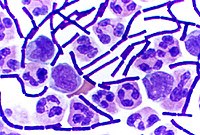
Photo from wikipedia
The inherent ability of bacteriophages (phages) to infect specific bacterial hosts makes them ideal candidates to develop into antimicrobial agents for pathogen-specific remediation in food processing, biotechnology, and medicine (e.g.,… Click to show full abstract
The inherent ability of bacteriophages (phages) to infect specific bacterial hosts makes them ideal candidates to develop into antimicrobial agents for pathogen-specific remediation in food processing, biotechnology, and medicine (e.g., phage therapy). Conversely, phage contaminations of fermentation processes are a major concern to dairy and bioprocessing industries. The first stage of any successful phage infection is adsorption to a bacterial host cell, mediated by receptor-binding proteins (RBPs). As the first point of contact, the binding specificity of phage RBPs is the primary determinant of bacterial host range, and thus defines the remediative potential of a phage for a given bacterium. Co-evolution of RBPs and their bacterial receptors has forced endless adaptation cycles of phage-host interactions, which in turn has created a diverse array of phage adsorption mechanisms utilizing an assortment of RBPs. Over the last decade, these intricate mechanisms have been studied intensely using electron microscopy and X-ray crystallography, providing atomic-level details of this fundamental stage in the phage infection cycle. This review summarizes current knowledge surrounding the molecular basis of host interaction for various socioeconomically important Gram-positive targeting phage RBPs to their protein- and saccharide-based receptors. Special attention is paid to the abundant and best-characterized Siphoviridae family of tailed phages. Unravelling these complex phage-host dynamics is essential to harness the full potential of phage-based technologies, or for generating novel strategies to combat industrial phage contaminations.
Journal Title: Viruses
Year Published: 2018
Link to full text (if available)
Share on Social Media: Sign Up to like & get
recommendations!